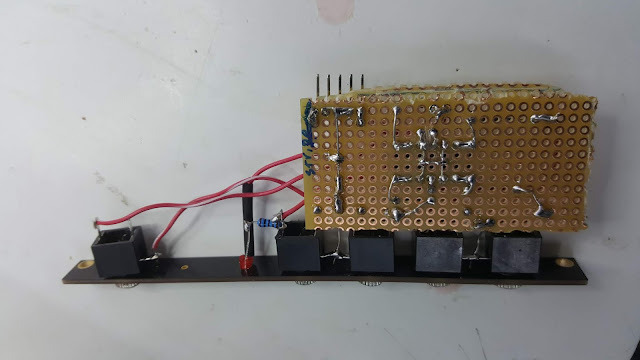A brief timeline of the Buchla Synthesizer
1937 ------------------- Don Buchla born in Southgate California
1959 ------------ Don Buchla received a degree in physics (University of California, Berkeley)
1962 ------------------Don became involved with the San Francisco Tape Music Center
1964 ------------------------ design of the 100 series Modular Electronic Music System started
1965 ----------------- The first 100 series is delivered to the SFTMC
(San Francisco Tape Music Center). The SFTMC eventually became
Mills College.
1967 ---------------------
"Silver Apples Of The Moon" released
(Morton Subotnick)
1968/69 ----------- the Series 100 was sold to
CBS Musical Instruments
1969 -------------------
Buffy Sainte Marie's album,
Illuminations
1970 ------------------------------------------- the 200 series Electric Music Box
1971 ------------------ 237/238 keyboard created (the first polyphonic modular controller keyboard)
1972 ------------- the 500 series, hybrid digitally controlled analog synthesizer announced.
It was designed over previous years.
1973 ------------------------- Buchla Music Easel
1976 ----------- the Series 300 (Don combined the Series 200 with microprocessors).
This was actually started in the Autumn of 1975, but 76 was when the
work was really done.
1978-1980 ------------------------------------------------ Touché
1978/9 -----------------
Sili-Con Cello (This was a performance based piece, not a product).
1982 ------------------------ Buchla 400
1986 ---------------------------------------------- the Buchla 700 with MIDI
1989 ---------------------------------------------------- Thunder controller
1991 --------------------------------------- Lightning controller
1995 ------------------ Oberheim OB-Mx
1996 ------------------------------------------------- Lightning II controller
1999 ------------------------- Marimba Lumina (gold edition)
2000 --------------------------------------------------- Marimba Lumina 3.5 (silver)
2002 ---------------------------- Marimba Lumina 2.5
2002 ------------------------------------- Piano Bar (Manufactured by Moog)
2002 ------------------------------------------- Barber Pole modules released.
2004 ---------------------- 200e series
2012 ------------------------------- BEMI formed
2013 ------------------------------------------- BEMI re-introduced the Music Easel.
2014 ------------------------ Don is forced out by BEMI
2014/5 ---------------------------------------------- 252e
2016 -------------------- Don Buchla passes at the age of 79 on September 14.
2017 ----------------------------------- BEMI released the Easel AUX Expander
2018 --------------- Buchla USA formed - BEMI takes on a partner & rebrands as Buchla USA
------------------------------------
Buchla 100 series
This synth was commissioned by Morton
Subotnick and Ramon Sender in 1963 and funded by a $500 grant from the Rockefeller
Foundation. The earliest modules have no company name on the front
panel, or are labeled "San Francisco Tape Music Center." The 100 series company was sold to CBS in 1969. These later modules are labelled CBS musical instruments.
The original instrument was installed at the San Francisco Tape Music Center in 1965 and moved to Mills College in 1966.
Buchla 200 series
The Buchla 200 series Electric Music Box
replaced the 100 series in 1970. This was a huge
advance in technology with greater use of CVs (control voltages)
Buchla 500 series
The first hybrid synthesizer. A computer was now added to to a analog synthesizer aid the process of
music creation
Buchla 300 series (1976)
This system employed digitally controlled 200 modules.
It included a computer
It's a Digital/Analogue Hybrid Music system . It used Patch IV software for routing control signals and inputting program data. The software was initially developed for 8080 & Z80 based machines
Touche (1978 - 1980)
Used a traditional 61 note keyboard. It was a hybrid digital computer married with analog circuitry.
8 voice polyphonic synth with 3 oscillators per voice.
It was controlled using a computer running FOIL (Far Out Instrument Language).
Apparently only four of these were ever made
400 Series (1982)
No patch chords!
6 voices of Digital oscillators.
Uses the MIDAS computer language to program the oscillators, filters, amps etc
Designed for film scoring ?
700 series (1987)
The first MIDI Buchla device. It also had CV/Gate, SMPTE, and two
RS232 ports.
Almost all the controls are touch plate (apart from 5 pots).
12 voices with 4 digital oscillators per voice.... that's 48 oscillators
6 modifiers per voice.
15 envelopes per voice. Each envelope can have up to 96 breakpoints.
It ran MIDAS VII software
Thunder (1989)
The first assignable MIDI controller based on ergonomics.
The human hand placement was foremost in its design.
Nothing like a standard keyboard.
Lightning 1991
It has two wands or sticks that are sensed by the main unit.
Marimba Lunina 1999
The mallets have radio transmitters in them.
------------------------------------------------------------------
++++ the dates and info are as accurate as I can find ++++
++++ If there are any mistakes or omissions please shoot me and email +++++





















 ..
..




























